Sparrows And Spiders
(Header Image: Swamp Sparrow)
Is our “patch” TOO convenient? I mean, within ten minutes we can be in the middle of some pretty decent birding territory. So it is no wonder we tend to visit it more often than other, more distant locations. As Gini said on this morning, we always see SOMETHING special out here!
Today was no different.
Central Florida has only four species of sparrow which breed within the state: Bachman’s Sparrow (Peucaea aestivalis); a Florida sub-species of Grasshopper Sparrow (Ammodramus savannarum floridanus); House Sparrow (Passer domesticus) – an introduced old world species; and, a bird many forget is actually a sparrow, the Eastern Towhee (Pipilo erythrophthalmus). There are three sub-species of Eastern Towhee in Florida, each having a different color iris.
As late fall arrives, so do additional species of sparrows. Our local patch, Tenoroc Fish Management Area, is blessed with abundant habitat attractive to hungry visitors from the north. We found three migratory species this morning: Swamp Sparrow, with its distinctive rusty wing patch; Savannah Sparrow, crisp streaks and yellow lores; and Vesper Sparrow, white eye ring and longish tail bordered in white (obvious in flight).
Florida’s weather is not just attractive for tourists wanting to escape frigid temperatures and snow shovels. Insects are able to thrive here most of the year. Which is why we are blessed with such a variety of avian migrants, many of which overwinter if the air doesn’t get too cold.
Gini spotted “something” in the field. It appeared the tops of a couple of dried woody-stemmed weeds had been encased in silk and drawn together. Closer examination revealed a brown-colored “pouch” in the center of the mass. Even closer examination revealed a green guardian close to the “pouch”.
The Green Lynx spider was ready to repel any would-be attackers as she protected her egg sac. That sac could contain as many as 600 eggs, with about 200 being average. When the time is right, she will rip the top from the sac and hundreds of new spiderlings will emerge. They will remain in the enclosed “webbing” for two to four weeks and then they’re on their own.
Green Lynx spiders (Peucetia viridans) are common throughout the southern United States from coast to coast, Mexico, Central America and the West Indies. During this particular morning, we spotted at least a dozen of these enclosed egg sacs, each with Mama Spider ready to eat us. (Well, that’s a bit dramatic.)
Our trip today was somewhat shorter than normal and we found not only sparrows and spiders, but also a falcon, a preening ground dove, the bluebird of happiness, a marsh marauder, a hanging dragon and a more sinister scaly beast at the creek!
A beautiful day, a gorgeous companion and the infinite diversity of Nature displayed in all its glory!
Life. Is. Good.
A pair of American Kestrels circled over an open grassy field for a moment and the female came close enough for a picture. These are North America’s smallest falcons.

True to its name, the Common Ground Dove spends a lot of time, well – on the ground. Once in awhile, though, a tree branch is a great place to rest and clean one’s feathers. Preening offers us a good chance to view the rich reddish-brown underside of this little dove’s wings.


Brown crown, gray neck and breast, whitish throat, yellow behind the bill and rusty wings help identify a Swamp Sparrow. Habitat helps, too. They are typically found low in the brush near water.
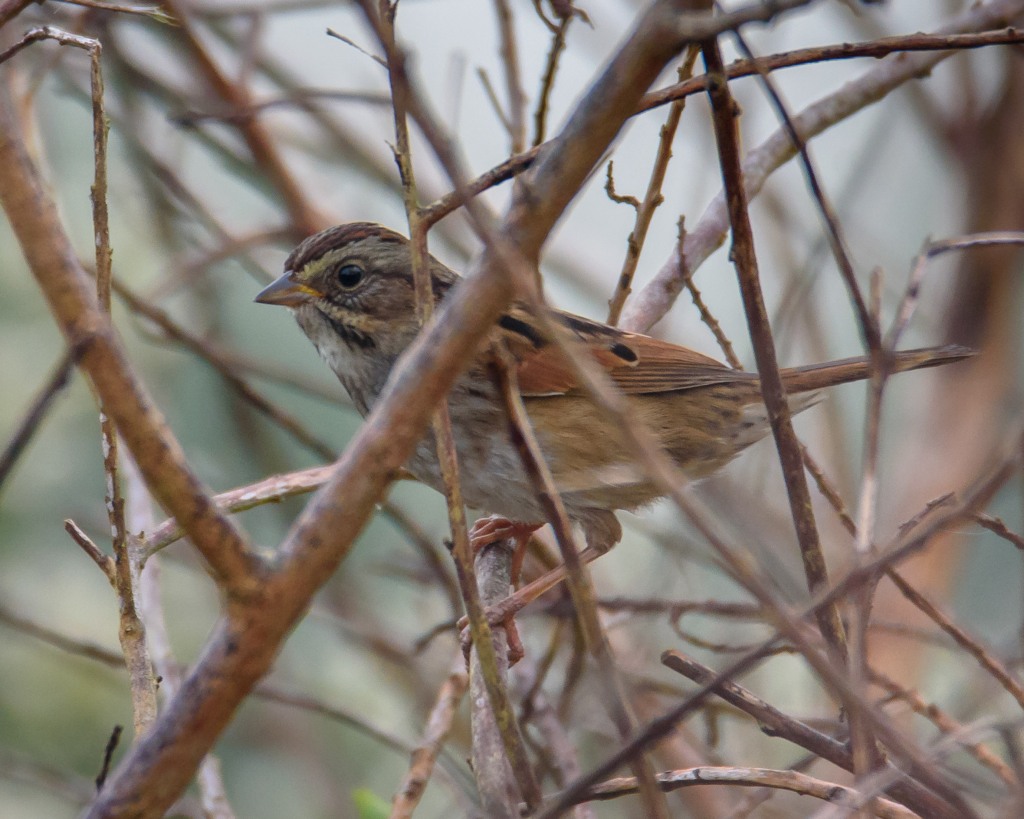
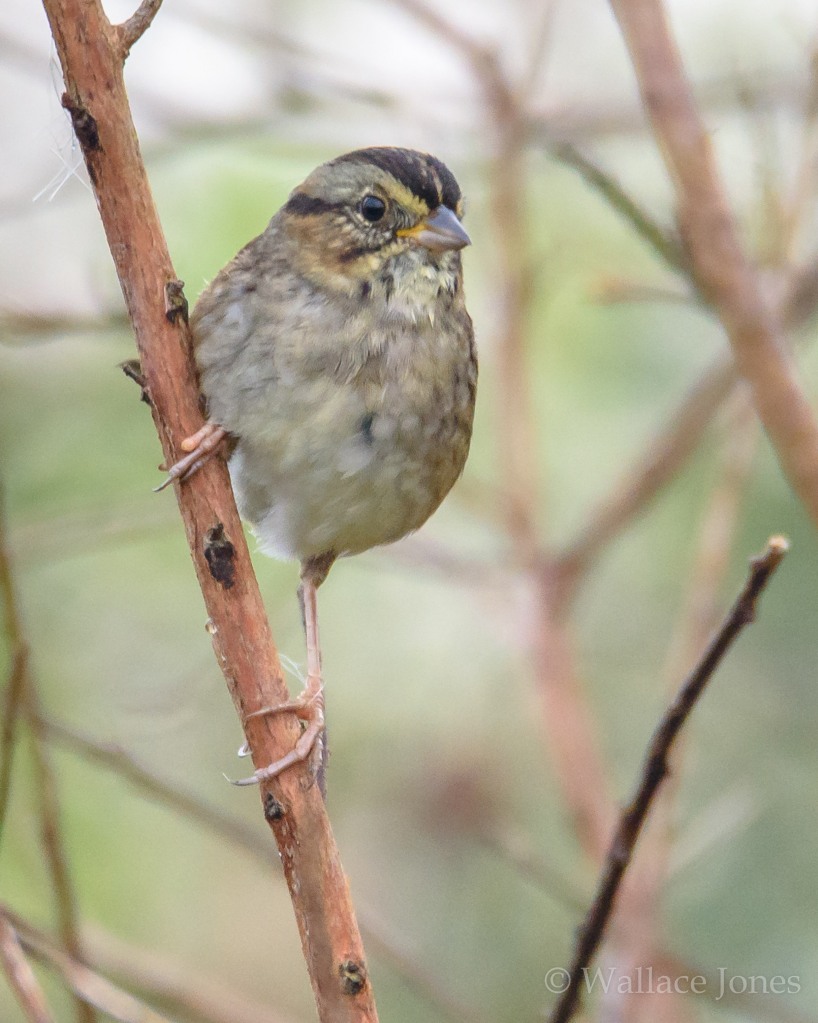
At the south end of a large open field, we can usually find a few Eastern Bluebirds. Today was no exception and one even perched close enough even I could get its picture. Now, if I can just train them to perch on tree limbs instead of wires.

One of our regular winter migrants used to be called a Marsh Hawk, due to its preferred hunting area. Bird-naming-bureaucrats with omnipotent powers decided one day that this beautiful raptor should henceforth be called a Northern Harrier. Splendid to watch, no matter what she’s called.
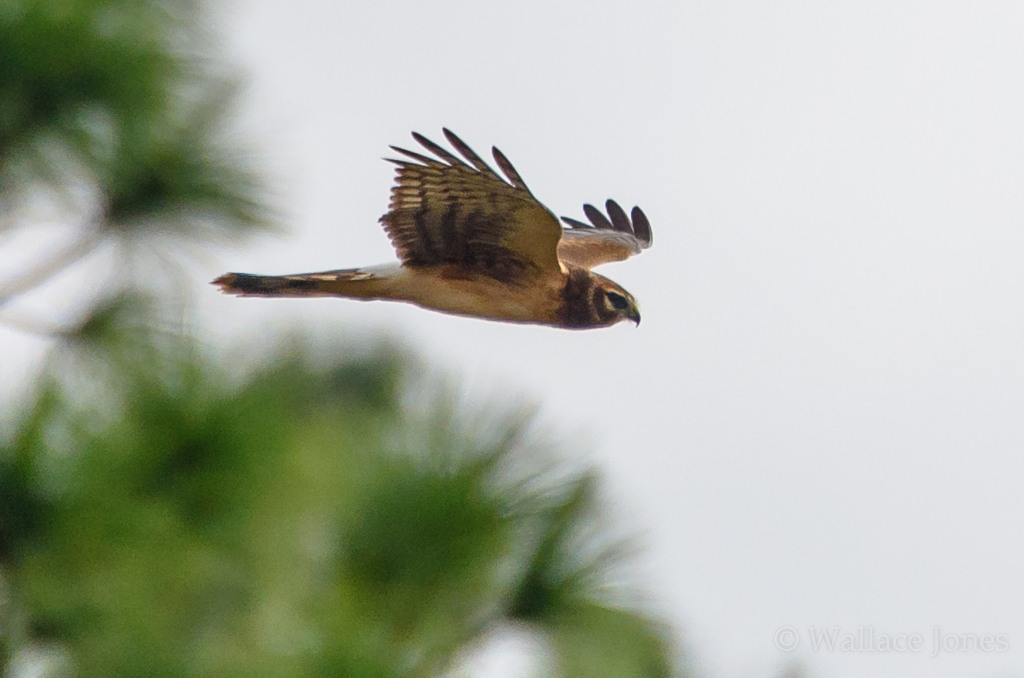
Once Gini found the first Green Lynx spider (Peucetia viridans) nursery, they seemed to be everywhere. Below are images of egg sacs protected by that fiercest of sentinels – MOTHER!

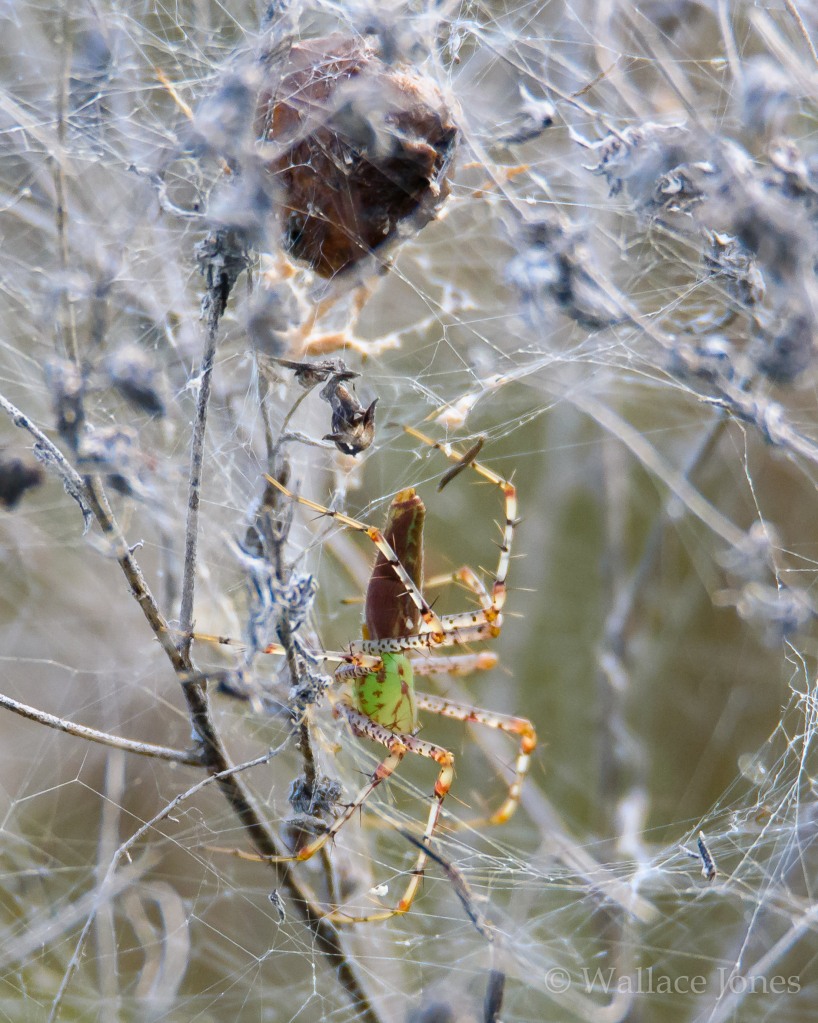
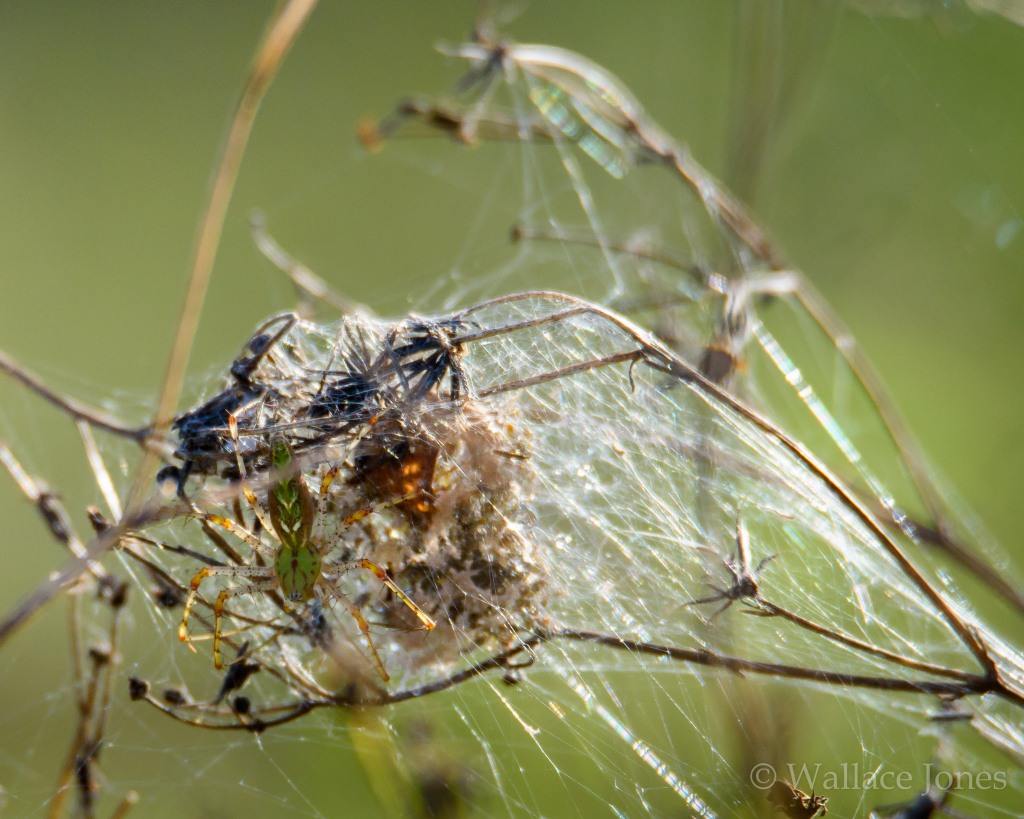
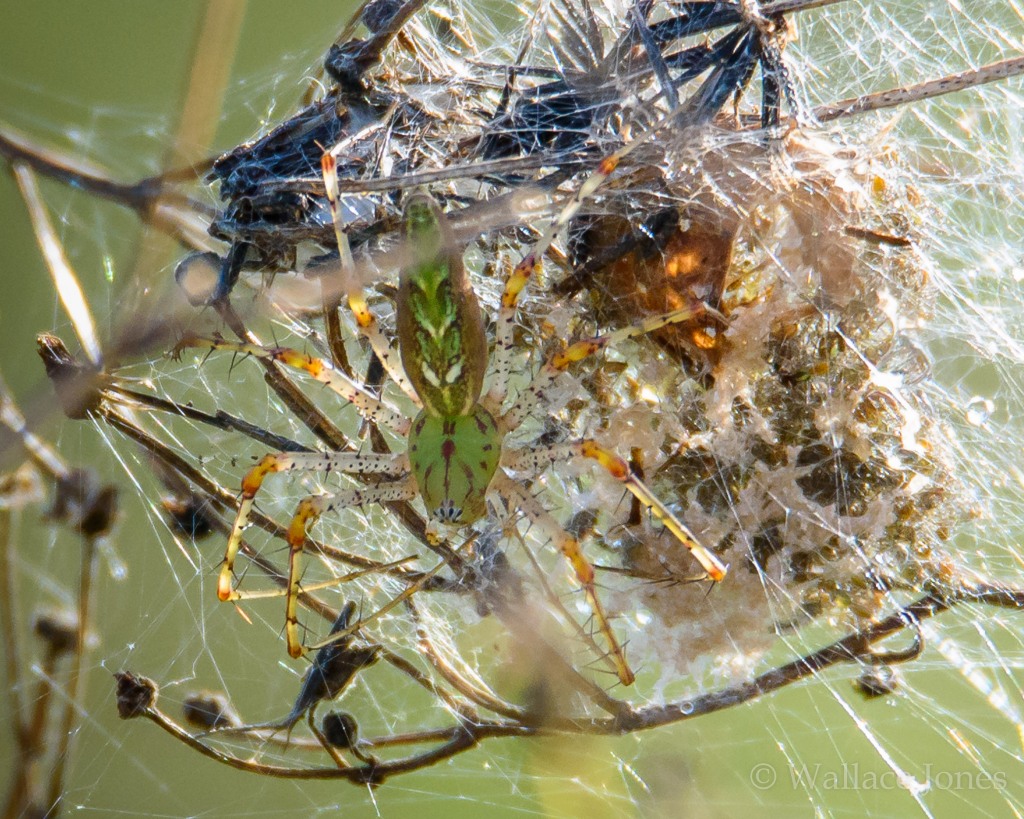


The handsome Savannah Sparrow prefers drier habitat than his Swamp cousin. Brown above, light below, crisp streaks and usually a yellow patch in front of the eye.
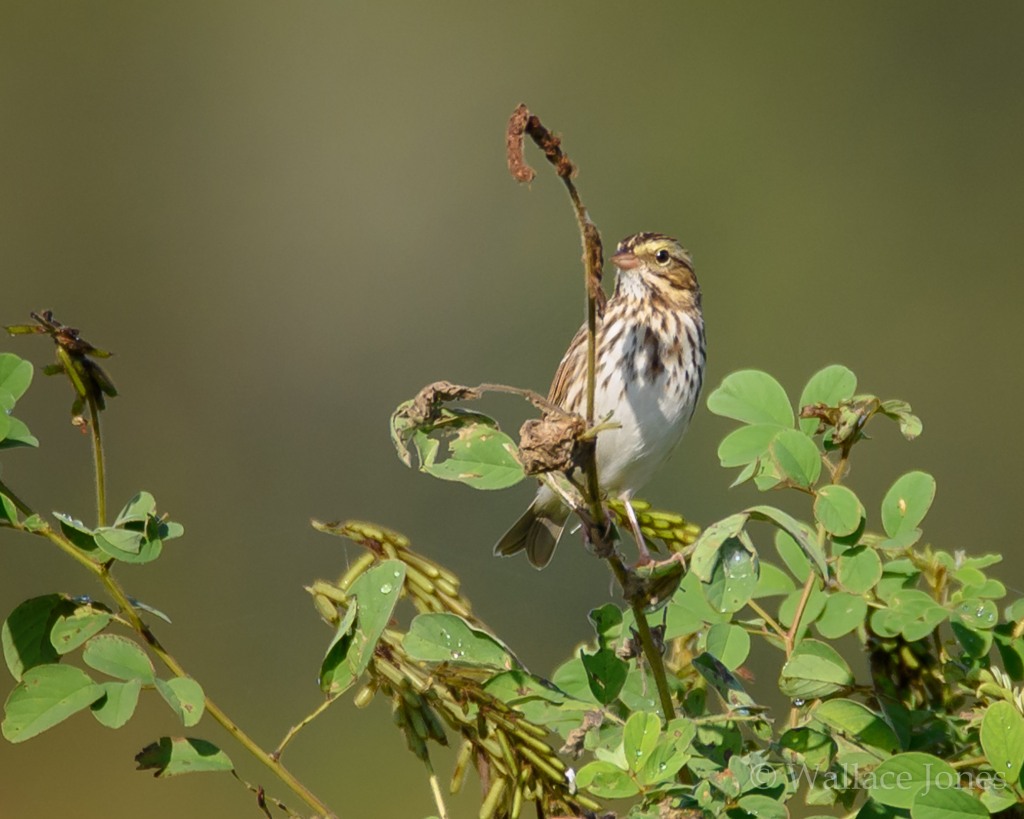
At first glance, the Vesper Sparrow appears similar to the Savannah. A white eye ring helps identify it along with white outer tail feathers which are visible in flight. Also, the Vesper lacks the yellow around the eye which the Savannah sports.

Odonata activity has slowed down as a series of cold fronts recently moved through the state. We were a bit surprised to encounter a Blue-faced Darner (Coryphaeschna adnexa) just hanging around.

“That creek looks so inviting”, Gini sighed. “Wouldn’t it be great to kick off our shoes and wade in that clear water?” I seldom disagree with my bride – for health reasons. This time, however, I suggested she glance to the left just a bit. “Oh. Never mind.”
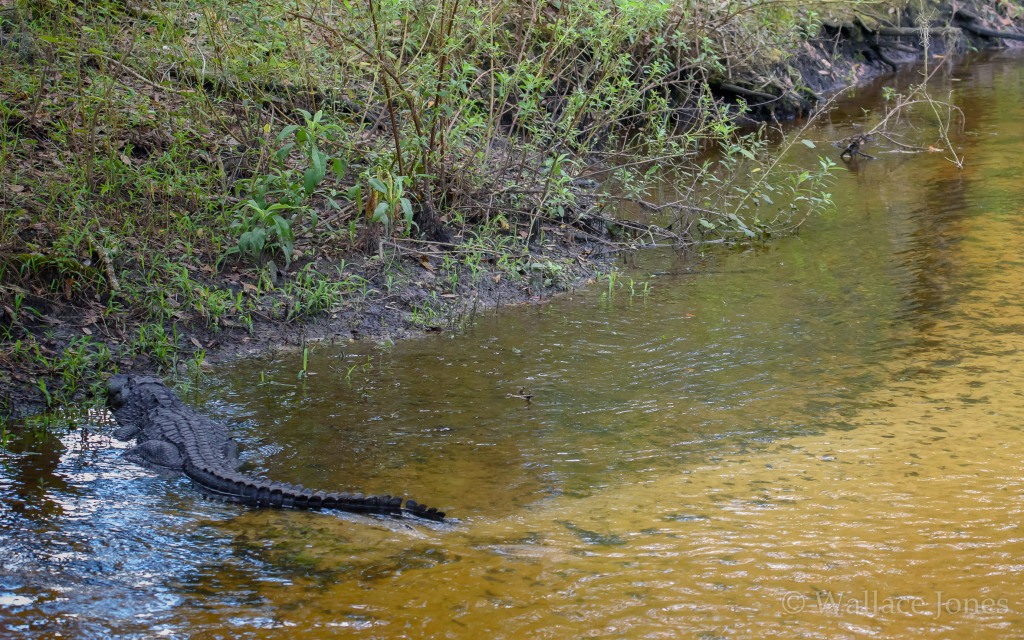

We had a fantastic morning ferreting out sparrows and marveling at the Green Lynx spider’s life cycle playing out right before our eyes. Breakfast was but a memory and now it was time for a treat to take home. Cuban sandwiches and Spanish bean soup. Yum!
Enjoy your search for a natural place and come back for a visit!
Sorry I’m late visiting. My Mac died on the 13th and I still don’t have it back from the repair shop.
What a beautiful assortment of birds. Adore the Savannah and Swamp Sparrows. I haven’t seen either one in forever. Nice find on the Green Lynx Spider and the circling Kestrel. You and Gini sure have a lot of fun adventures.
Living in a tropical-like environment is definitely an advantage for attracting bird species. I wish more would stay here. They pass thru with their winter plumage, then get all their bright colors farther south later in the year. Costa Rica is on my bucket list.
LikeLike
Sorry to hear the Mac fell ill. Hope your’re back up and running soon!
We are absolutely spoiled with Nature’s riches! Wouldn’t have it any other way.
Hey, we share a similar bucket!
LikeLike
What a fabulous post about a wonderful morning! Your informative narrative and your photos are all such a treat!
LikeLike
How kind of you! We appreciate your visit.
LikeLiked by 1 person
Really enjoyed this trip and learned something new too. Which is as usual here, but this time it was about fascinating spiders instead of birds.
Sallie
LikeLike
Hi, Sallie! Hope your winter isn’t getting too bad.
Thank you for dropping by and making such nice comments! We’ll save you some spiders for your next trip. 🙂
LikeLike
Beautiful shots, Wally, I especially love the Swamp Sparrow close-ups! Although I am petrified of spiders, the Green Lynx mommy is gorgeous!
LikeLike
Thank you very much, Donna.
No worries about the lynx spiders. They seldom bite humans and won’t hurt (much) if they do. Not toxic.
LikeLiked by 1 person
Fascinating info and photos about the Lynx Spider. I wonder if they rage down here to south Florida. The past couple of winters have been bad for sparrows in our local patch. Last year I only saw one White-crowned Sparrow (only my third sighting of the species in 10 years) but none of the usually common Savannah and Swamp Sparrows and occasional Grasshopper and, rarely, Clay-colored and Chipping Sparrows. The cold snap reminded me to look for sparrows. Believe it or not, I have never seen a House Sparrow in the wetland patch, although they show up in a shopping center a mile away.
LikeLiked by 1 person
Thank you, Ken.
The lynx spiders are found throughout Florida. Spotting them may be another story!
I think the sparrows are masters at remaining hidden, at least when they know I’m around. Walking through a field the other day, I spotted six individuals playing “hopscotch” in front of me. Couldn’t find a single one of them for i.d. Sigh.
LikeLike
This post, as are all your offerings, Wally, is filled with a variety of interesting critters, but the Green Lynx Spider is the star for me this time around. I have seen a couple of species in this family in Central America and was curious to learn that they come by the name Lynx Spider due to their habit of jumping on prey from the top of a plant. The male also dances in front of the female during courtship, implying that their eyesight is better than the average species, and they copulate clinging to a silk thread. As far as I know the male does not become dessert for the female. Fascinating series of pictures! As they used to say when full service at the gas station was de rigeur, “Have a nice day!”
LikeLike
We, also, are fascinated with the green predators. Watching one jump up and capture a Hummingbird Moth in flight was the highlight of my year!
Our day here is stormy but the aroma of baking Christmas cookies and freshly brewing coffee is helping to make it a “Nice Day” for certain!
LikeLike
No, Wally. I don’t think your patch is “too convenient”. I’d say it’s just right!
Well, maybe it’s too convenient for us readers. All we have to do is avidly consume your posts about all the things you find there. I enjoy reading / learning about them – thanks for posting.
Ed
LikeLike
Thank you, Ed. I strongly suspect we’ll keep visiting there.
However, we REALLY need to make an effort to break away and head to the Space Coast!!
LikeLike
That’s a pretty wonderful patch that you have virtually on your doorstep, Wally! This post from you turned out to be a three-Google post for me – a rarity. The first Google was to further investigate that Green Lynx Spider – interesting! Subequent Googles were for Cuban sandwich (I’m now feeling quite hungry!) and Spanish bean soup (probably not to my taste as I don’t like chorizo, and have an uncomfortable intolerance of bell peppers).
That Blue-faced Darner is a real winner. I’ve been trying to work out whether it’s a male or female, and (from the underside) am coming down on the side of the latter? Who couldn’t love an Eastern Bluebird!
Thank you for your vigilance in protecting Gini – I thought that she was the one with eagle-eyes!
I hope that the Covid vaccine comes your way soon. In the meantime, both of you take good care and stay safe – – – Richard
LikeLike
Thank you, Richard. It really is a great place.
Our local Spanish bean soup is a recipe formulated by Cuban immigrants who settled in the Tampa Bay area over 100 years ago. It usually is made with a ham bone or smoked ham hocks and onions, garbanzo beans and potatoes but no green peppers. Cuban sandwiches Tampa-style are also a bit different than Miami or Key West-style. Subtle – but important – differences!
You are right about the darner being a female. She has a green face whereas the male’s is bright blue.
This week is Christmas crafting and cookie baking week! Yum!
Both of us wish both of you all the best.
LikeLike
I spent last week exploring some of the Texas hill country’s natural places. It may have been the last truly splendid streak of weather for a while — 70s, low humidity, blue skies, no wind — and although much of the flora was fading away, I did see a flock of wild turkeys, a live armadillo crossing the road in front of me (missed!) and uncountable white-tailed deer. Thanks to your photo and description, I ‘m fairly sure I saw Savannah sparrows, and I know I saw cardinals, Carolina wrens, and a woodpecker I’m still a little uncertain of.
There were a few dragonflies still flitting. Your photo of the blue-faced darner is just superb, but my favorites are of the Green Lynx spider. It’s one of my favorites, and this has been a good year for them around here.
LikeLike
Thank you for sharing your hill country moments. We miss Texas!
The spiders have been fascinating to watch this year. We have seen more in the act of catching prey than in the past and the egg sac observations have off the chart.
Plague or no plague – Houston is in our sights not long after the new year!
LikeLiked by 1 person
My dose of weekly sunshine.
Absolutely love the Darner shot and your Sparrows are pretty neat (we only have 2).
LikeLike
Happy we had a bit of spare sun to share, Brian.
Any day we can see sparrows and darners is a good day!
LikeLiked by 1 person
Too convenient? Queue hysterical laughter. If it ain’t broke don’t fix it. And having this haven so close to home is the antithesis to broken.
Thank you (as always) for inviting us along.
LikeLike
Thanks, E.C.! But – since it’s so close, does it make us so lazy we stop planning visits further away? Oh, wait, if the birds and bees are there – who cares how close it is!
Whew! Okay, we’ll keep going there.
You are welcome to come along any time!
LikeLike
Love this!
LikeLike
Thank you!
LikeLike